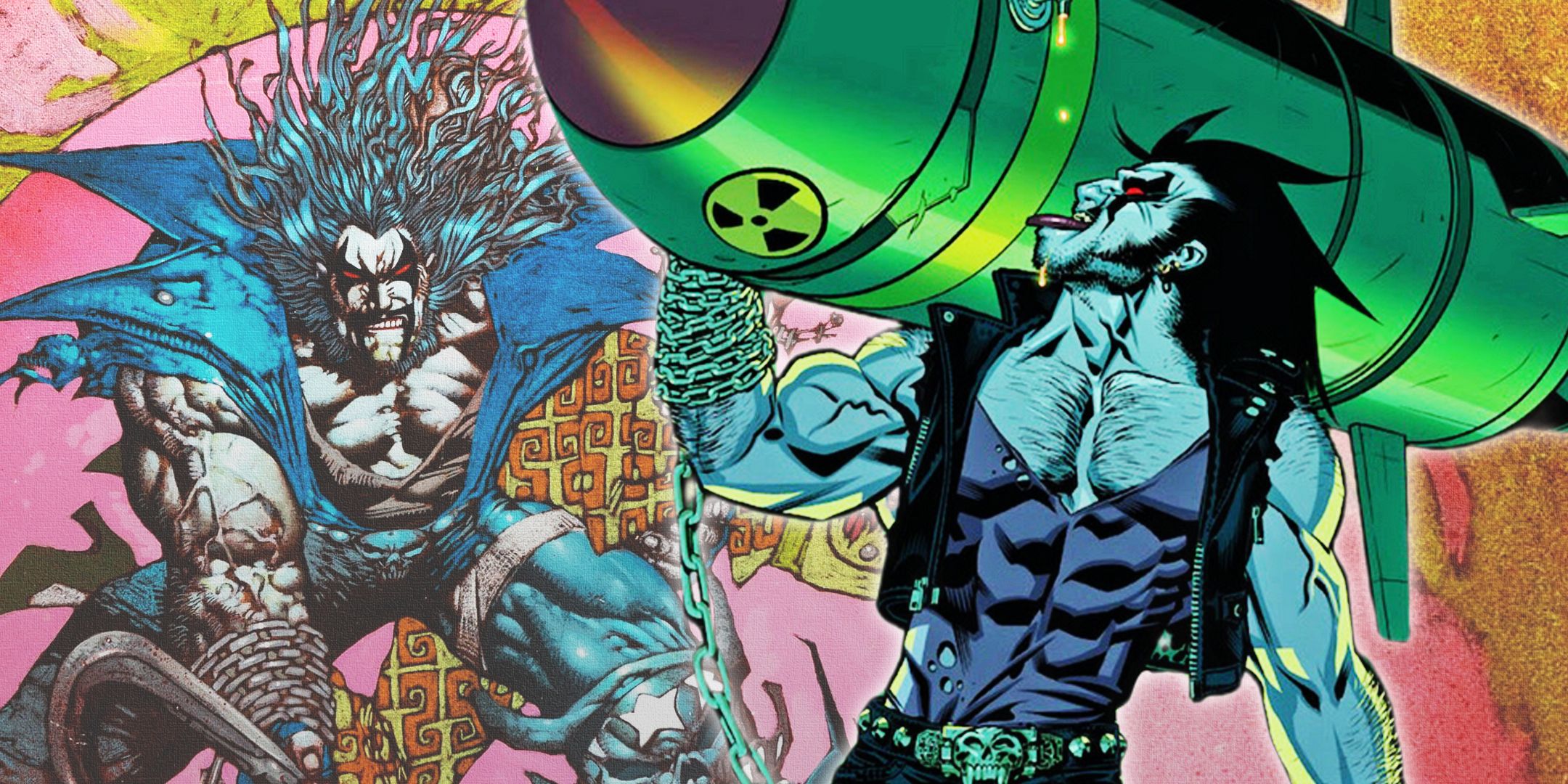[[{“value”:”
When Lobo first appeared in Omega Man #3, written by Roger Silfer with art by Keith Giffen and Mike DeCarlo, he looked very different. Even then, under the whimsical leotard, the cold Czarnian heart of a genocidal maniac waited to blossom. Nowadays, he’s recognized as just about the gnarliest bastich in any space sector.
He can track a bounty across the universe by smell alone and the most evil song ever is constantly beaming into his brain – at his request. The Main Man’s got a lot of great stories, but his best ones showcase his complex and sophisticated sensibilities and talent for doing what he does best: fragging everything in sight. Fans might want to bone up on the Last Czarnian before he’s brought to the big screen by Jason Momoa in the DCU’s live-action adaptation of Supergirl: Woman of Tomorrow.
Related
Supergirl: Woman of Tomorrow Fan Art Shares Hypothetical Look at Jason Momoa’s Lobo
‘Lobo is on his way!’ A piece of Supergirl: Woman of Tomorrow fan art by BossLogic shares a hypothetical look at Jason Momoa’s Lobo.
10
Lobo Unbound Is Great For Beginners
Keith Giffen’s Lobo Unbound is a quintessential Lobo comic. It retells the Main Man’s origin, then quickly moves into a gorgeously rendered plot where Lobo is the good guy because the worlds around him are so bad. Alex Horley and Byron Vaughn’s art is reminiscent of 80’s sci-fi classics like Heavy Metal, and the story is a fresh installment of a pretty classic setup.
When a sect of long-necked mammal people hire him, he eventually takes over their society. He starts killing indiscriminately until he eventually deals with the entire population of their planet all at once. It’s a series that reminds readers why they should hate Lobo – especially if they’re socially conscious – but ultimately clarifies that the real bad guys are the corrupting forces he opposes.
Lobo’s complicated relationship with the afterlife is explored in his solo series, but no comic takes it as far as Alan Grant’s Lobo: A Contract on Gawd. The series opens with the Main Man hurtling through the cosmos to the rockin’ musings of Steppenwolf’s “Born to Be Wild,” and quickly turns to chaos as a clan of monks hires Lobo to kill their omniscient god. Lobo decides he’ll do it for free, and the theological quest showcases his satirical lack of morals.
Lobo’s too bad for Heaven and Hell cannot hold him. Other series explore this as an explanation for his apparent immortality, but Contract on Gawd is more of a simple show of power. He tears through buff priests, carnivorous cherubs, the damned, and more. His conversations with the childlike deities showcase his warped mindset, and his fated role in a global-scale battle of good and evil means very little to him.
8
Crush and Lobo Modernizes The Main Man
Mariko Tamaki and Amancay Nahuelpan’s Crush and Lobo is an eight-issue series that revisits old themes for a modern audience. The satire and parody of Lobo’s old adventures include reprehensible displays of misogyny and other abusive and toxic behaviors, as women have historically been hypersexualized in comics and pop culture and Lobo is bad. Crush and Lobo gives the other side of a story the comics alluded to for a long time.
Related
DC’s Toughest God-Killing Anti-Superman Has a Surprisingly Basic Weakness
Lobo’s daughter Crush just found out how to take down her father, and her method is not only bizarre but surprisingly simple.
The Main Man is a notorious scuzzball (and proud of it), so it’s common knowledge that he has children he doesn’t know about. Crush struggles with her Czarnian heritage and the weight of her father’s terrible legacy, and the series shows his unwillingness to change. It preserves the worst things about him while putting his best traits into his daughter and also repairs the New 52 redesign.
7
Lobo Crossovers Are Intense And Chaotic
Violent cartoon characters with bottomless pockets full of whatever artillery they can imagine are as common as fantastically powerful hitmen and unkillable mercenaries. Lobo can’t be contained and never misses an opportunity to leave his mark on another property. His meeting with Wolverine in DC vs. Marvel #3 doesn’t end well, but it indirectly spawned Lobo the Duck, so it was worth it.
Lobocop is an exercise in throwing Lobo into any situation that seems cool, and it meets its mark. Lobo/Judge Dredd is similar, putting the untamable bounty hunter into a rigid and gritty world, pitting the protagonists against each other until their eventual team-up. The two-part Lobo/Mask series is the best of Lobo’s rad crossovers, centering on the underlying cynicism beneath both outwardly cartoonish madmen.
6
Unamerican Gladiators Let Lobo Cut Loose
Unamerican Gladiators introduces new settings and characters that only work in Lobo’s world. Hulking cyborgs and vicious murderers from around the cosmos show up on a greasy cesspool of a planet to participate in a big-shot baron’s “Maim Game.” The series opens with him killing a man for a goldfish, and it only escalates from there.
Sixteen teams are looking to win a planet-destroying super weapon in the Maim Game. They include lowlifes from a dozen planets, a time-displaced World War 2 platoon, and one minimally interested Main Man. Lobo’s over-the-top antics make great television, so the overseers are excited over his participation, but there are no winners when people play games with the Main Man.
5
Lobo Shines In One-Shots
Nobody does one-shots like the Main Man, and there are too many to choose just one. He was featured in L.E.G.I.O.N. Annual #1, and several annual issues of his own various series. The anthological Elseworld tale A Fistful of Bastiches features a world of western-themed Lobos, and In the Chair puts one Lobo into a Western world. They’ve got light-hearted satirical ultraviolence, just like his Paramilitary Christmas Special, showing glimpses of his well-hidden caring side.
Related
Comic Books Need More One-Shot Stories
One-shot stories are perfect ways for new readers to jump into a character or series, and the comic industry should prioritize making more one-shots.
The Lobo Convention Special is a wild ride where the Main Man attends earthly comic book conventions, making satirical commentary and references about the culture that produced him. Lobo: Portrait of a Victim is utterly depraved, highlighting what makes Lobo a uniquely awful villain, while Lobo: Fragtastic Voyage is a visually stunning sci-fi fever dream. Even the 2024 Cancellation Special is a great read because they all have fun with a great character without losing sight of the fact that he’s a bloodthirsty and vicious bad guy.
4
Lobo’s Second Solo Series Is More Of His Best
Lobo’s second solo series lasted much longer than the first. By 1993, The Main Man was a fully fleshed-out character who could stand alone. He didn’t need to be an unofficial tagalong member of some second-string team or a wacky one-off space villain to test budding villains. It gave Lobo his own space to develop into the lovable monster he is today.
Existing in his own private corner of the universe allowed Lobo’s individual mythos to grow unrestricted. He occasionally interacted with L.E.G.I.O.N. contacts like Vril Dox, but he also met new heroes like Goldstar on worlds built for him to destroy. Lobo vol. 2 also introduces Lobo’s interesting relationship with Etrigan, the Demon, and explores the complex morality of both.
3
Infanticide, Death, and Taxes Closed A Brilliant Run
Lobo by Keith Giffen and Alan Grant Volume 2 collects the later Lobo comics by Giffen and Grant. The stories are unhinged, following the Main Man’s bounty-hunting appearances around the DC Universe to natural conclusions of white-collar crime and family conflicts. Infanticide follows Lobo as he trains an army of dweebs and geekoids in the art of brutal murder, unaware that they’re his children until after all 200 of “Lobo’s Bastards” meet comically violent ends.
A salon owner named Ramona is a point of contact for the otherwise nomadic Main Man, and in Lobo: Death and Taxes (also collected in the omnibus), Lobo regurgitates a fax from an implant in his chest and agrees to kill her lover over a tax dispute. Lobo never pays taxes, escalating to ludicrous, satirical violence, as all good Lobo stories do. Collected as an Omnibus, the two stories greatly summate Lobo’s interpersonal relationships.
2
The JLI Established Lobo
The Justice League International was a messy and fluctuating team, but Guy Gardner’s adversarial relationship with Lobo is always the same. They’re both hot-headed brutes who prefer fists to brains, but they’re also both often misunderstood. Keith Giffen and J.M. DeMatteis’ Justice League International #18 shows Lobo’s softer side for the first time, and the following issues show everything else.
Related
10 DC Villains Who Became Heroes (& Why)
DC Comics has created countless villains, so it’s only natural that a few have transformed into heroes.
It’s The Main Man’s big reintroduction after a relatively goofy first appearance, and it built a lot of long-standing lore despite feeling like a villain-of-the-week setup. Gnort’s warnings about the properties of Lobo’s blood and his name’s meaning became staples of the character. The conflict goes well beyond the following issue: re-establishing Guy’s head trauma and starting Lobo’s beef with Earth. This small arc is the foundation upon which his solo series are built.
1
Bisley, Grant, and Giffen Made A Monster
The Main Man’s first solo series opens on Lobo as he rants furiously about an unlicensed biography. Simon Bisley’s art gives people strange, gawking, or bug-like proportions, rendering Lobo’s violent outbursts into silly gags and giving readers their first gory look inside his head. Lobo’s legend began with escorting his former school teacher after doing similar work in the pages of Keith Giffen and Alan Grant’s L.E.G.I.O.N. Bisley, Grant, and Giffen’s legendary run with the character is collected in a 2018 omnibus titled Lobo.
In his eponymous solo series, Lobo blasts through lizard people, spelling bees, fanboys, and more. He gets even more violent as he further separates from other DC characters in the pages of Lobo’s Back. The series brilliantly establishes Lobo as a wholly unique character and force of nature with incredible range, cementing his origins and exploring his rich, gory personal life. It separates him from worlds of moral absolutes and colorful superheroism, building all new context for Lobo in the DC Omniverse and letting him utterly dismember it.
DC Comics
DC Comics follow the adventures of iconic superheroes such as Superman, Wonder Woman, Batman, and more.
“}]] Fans of DC’s Main Man will want to dive into some of his best comics before the character makes his live-action DCU debut in the new Supergirl movie. Read More

